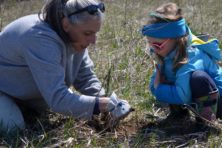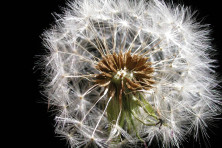October Plant Profile: Crown Vetch
- Share
- Tweet
- Pin
- Share
Crown Vetch (Securigera varia) is a herbaceous perennial with trailing stems ranging in length from 2 to 6 feet that form dense patches. It invades open areas with varying soil types and is often found along roadsides where it was first planted for erosion control. It is able to easily escape roadsides and move into natural areas where it crowds out native species.

Crown Vetch.
A member of the legume family, it also fixes nitrogen, which increases levels of the nutrient in the soil and threatens rare and endangered species. Like many other invasive plants, Crown Vetch reproduces vegetatively by rhizomes (underground, horizontal roots) that can grow up to 10 feet from the plant.
Crown Vetch flowers in spring and mid-summer, however is sometimes seen flowering into the fall. Its flowers are pea-like and range in color from pink to lavender to white. The flowers are arranged in flat-topped umbels that emerge from the axils (where the leaf meets the stem) and contain 14-20 flowers. The leaves of crown vetch are pinnately compound, alternating leaves with 11-25 oval leaflets. The number of leaflets will always be an odd number.
A number of vetch species are present in Wisconsin; crown vetch can be distinguished from other legumes by its compound leaves having an odd number of leaflets, its leaves and flower stalks arising from the main stem, and its flat-topped umbels.
Mechanical methods such as hand-pulling, digging and mowing only succeed if the entire root system is removed. These methods may be effective in reducing the vigor of the stand and suppress it, but will likely not eradicate the crown vetch. Herbicide can be applied to crown vetch via a foliar spray after the plant has completely leafed-out and while the plant is still actively growing. A foliar spray is an application of the herbicide directly to the leaves and stem of the plant, without cutting or injection.
In Wisconsin, crown vetch is not regulated by Chapter NR40 (Wisconsin’s Invasive Species Rule). However, the Wisconsin Invasive Species Council recommends it for listing as ‘restricted’ in upcoming rule revisions. ‘Restricted’ means the plant is already widely established across the state and that high environmental and/or economic impacts from the species are evident.
To receive monthly newsletters containing information about local and regional invasive species issues, email the DCIST coordinator at [email protected].


